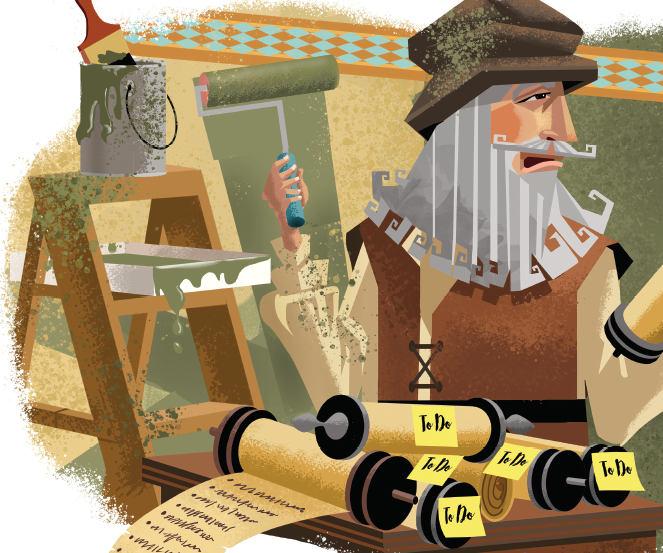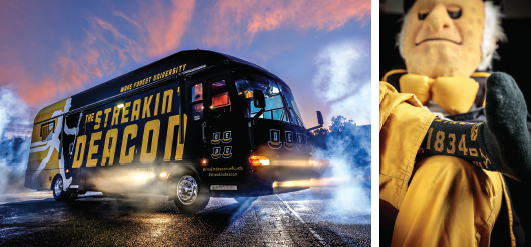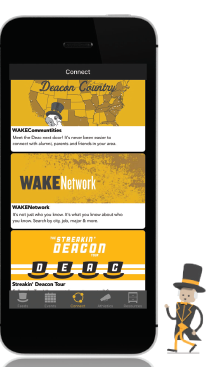The Art of Working Strategically

Let's face it: No one who works in communications and marketing wants to design flyers or write email copy every day. These professionals crave inventive yet impactful projects that will propel the school, college, or university they serve. But too often creative people devote their workdays to cranking out uninspired deliverables for Director So-and-So's upcoming event. When a marcomm team functions as a service-level agency, its members live in reaction mode. Its agenda is set by urgent requests from other units rather than the institution's strategic goals.
It doesn't have to be this way. Three years ago, the Office of Communications and External Relations at Wake Forest University in North Carolina transitioned to playing a more strategic role by focusing on work that enhances the university's brand and generates revenue through attracting fundraising gifts and tuition dollars. How did we change our circumstances? Through planning and by determining the type of work we want to accomplish. After implementing the following principles in 2015, our team produced 28 percent more strategic projects while decreasing our total number of projects by 34 percent. Our objective was not to do less work—we're busier than ever as the scope of strategic projects has grown—but to do more impactful work. This focus helped Wake Forest reach its initial campaign goal of $600 million two years early. Here's how we did it—and how you can too.
Clarify your team's purpose
This requires support and buy-in from senior leaders, but it begins with staff discussions that define the type of work the team should be doing and why, as well as what it can achieve by making such a strategic shift. I led our communications leadership team through an exercise in which members listed the top three projects they thought made the most impact across the university in terms of strengthening the brand and generating revenue. We looked for overlap among our votes and debated the merits of the choices. While people had different opinions about what was important, we agreed on enough areas of strategic importance to determine how to focus our efforts and accomplish our goals as a team.
Following this exercise, we discussed our plans with senior leaders in the University Advancement division, where our unit resides, and made adjustments based on their input. Reasonable leaders understand capacity challenges, but they care more about their own workload than that of your team's. We had to help them understand what was in it for them and how this strategic change would further their goals as well as the university's. We also met with key influencers, such as department heads for whom we often performed work, to discuss our team's capabilities and strengths and to help people understand what we were doing and why. These campus partners include our various graduate and professional schools with fundraising needs as well as offices such as the provost's and campus life. If you cannot clearly communicate the best use of your team's talents, nobody else will do it for you. People must understand why saying no to some things enables you to say yes to strategic projects.

DECKED OUT DEAC-STYLE: The Streakin' Deacon (near right), a 42-foot recreational vehicle that engages Wake Forest University Alumni in their communities, has traveled from coast to coast since its launch in September 2016. Its features includes a horn that plays the fight song, a 25-person roof deck, and four flat-screen TVs. The Demon Deacon (far right), the North Carolina institutions mascot, shows off the custom-made wool socks that were the centerpiece of the Wake Forest Fund's April 2017 campaign. More than 3,300 donors received a pair for their gift of $25 or more.
Prioritize what matters
In his book First Things First, organizational expert Stephen Covey tells a story about the need to focus on what's most important. In the tale, a speaker fills a clear jar with large rocks and then asks the audience if the container is full. They say yes—until he adds gravel and sand to fill in the spaces between the rocks. Finally, he adds water until the jar is brimming. The lesson: Put the big rocks—your top priorities—in first, otherwise you won't fit them in at all. Focusing on what matters most will strengthen your decision-making process and will help staff members decide what kind of team they want to be.

CONNECT THE DEACS: The DeacOn mobile app provides alumni, friends, and family one-stop shopping for Wake Forest University information and engagement opportunities.
After our team members listed and debated the previous projects that they believed had strategic impact, we
determined nine focus areas that became our big rocks in fiscal year 2017. They were not our only projects, but they were our most important. They included creating the brand for our new Wake Downtown campus; rebranding the alumni engagement office; launching alumni-oriented initiatives such as the DeacOn app and The Streakin' Deacon, a 42-foot branded recreational vehicle that engages alumni through regional and national tours; evolving the brand of our $600 million campaign and extending its goal to $1 billion; and designing a new university homepage.
We also worked on strengthening the recent rebrand of the Wake Forest Fund as an annual giving program that increases giving and participation, particularly among young alumni, through intriguing offerings. For our April 2017 annual fund push, for example, donors who gave $25 or more received custom-designed Wake Forest wool socks. The project, known as Feet of the Finest, shattered our previous donor participation record for the month of April by 65 percent. Projects like these have shown that we are on the right path. We have made a difference for Wake Forest's brand and bottom line and won accolades for our creativity, including three Grand Golds in CASE's 2016 Circle of Excellence Awards.
Create a decision-making model
How will you decide what work your team accepts and fulfills? What criteria determine whether a project enters your queue? We agreed on three factors that constitute a successful project: its capacity to strengthen the brand, its ability to generate revenue, and the strategic opportunity a campus partner's request presents. Previously, relationship was the primary condition: If someone deemed "important" wanted something, we did it. While we continue to value our relationships with campus partners, the three areas now carry equal weight. Senior leaders also understand that work on our strategic projects may affect the scope or timeline of work they request.
We are often asked to design T-shirts or similar one-off items for small events. When we apply our decision-making criteria to such jobs, they usually earn a low score, which leads us to decline them.
Criteria that help determine a project's value re-inforce your team's purpose, remind members what is important, and allow team leaders to think strategically about whether to accept the work. Such a process also helps your cross-campus partners understand the type of work your unit does and doesn't perform. Producing projects that advance the university's strategic priorities, drive revenue, and build the Wake Forest brand also influences how others perceive our office and make our services more desirable.
Forecast foreseeable work
Once our team has selected its big-rock priority projects for the year and gained buy-in from key stakeholders, we meet with our campus partners to forecast the next fiscal year's work. We tell them what areas we will be concentrating on, and we ask to partner with them on their big-rock priorities when possible. We initiated this process in early 2015, and since then, partner discussions have been more strategic. For fiscal year 2018, we limited our focus to four strategic projects, realizing that nine was about five too many. We will complete many more projects, but not at the expense of these areas.
Devise a plan for addressing work you won't touch
We rarely tell our partners, "We cannot help you." Instead we say, "We cannot perform this work for you because it doesn't align with the focus areas we have selected and because our capacity will not allow it, but we can connect you with one of our trusted, vetted, and trained freelance partners." Demonstrating the value our team brings when its work centers on senior leadership's vision for the institution has helped us gain a larger professional services budget to complete work that is beyond our capacity. We did this by obtaining buy-in on our big rocks and anticipating the resources we would need to devote to them. We do the same for the rest of the work we plan to achieve as well as projects our campus partners have requested. When you demonstrate the capabilities of your team and the resources necessary to accomplish the work, it often becomes clear that requests exceed capacity. Since we meet with our partners early in the process, we can forecast freelance expenses, which enables units to request funds for such jobs in advance. If the project is one that we should be doing but our capacity prevents it, our professional services budget often enables us to cover the freelance costs.
Adding to our stable of freelancers is an ongoing priority. So far in 2017, we've added nine digital freelancers to our list. The ability to delegate work to outside professionals allows us to assist our partners without diverting our attention from strategic projects.
The quest continues
We must prioritize the work that we know will make a difference for the institution. Changing course toward effective, strategic communications is challenging. We risk not being useful, angering people across campus, and earning a reputation for saying no. Overcoming these obstacles takes time and leadership support. Making such a switch can feel like swimming against the current after operating in a system in which waves of requests and work orders pummel your team. But teams that don't take this plunge will continue to succumb to everyone else's agenda, and their best ideas will remain untouched.
We're not doing the type of work that was requested of us three or four years ago. This doesn't mean we get to focus exclusively on the work we want to do. Work that makes little impact still enters our queue, and teammates are quick to point out how these small rocks may deter us from strategic work. But the culture is shifting. We are no longer primarily order-takers. Yes, unexpected projects still crash in on us like meteors. We're always adapting and negotiating. Capacity challenges are tensions to be managed rather than problems that are once-and-for-all resolved.
We're also striving to do our best work on the best projects in the best way while remaining mindful of our priorities. This allows us to say to a partner or a senior leader, "If we do this last-minute request for you, we can't do our best work on this priority. How do you want us to proceed?" Sometimes we have to manage the meteorite, but when we do, we make people aware of the cost.
I doubt we'll ever feel like we have time for everything we want to do, but that's not the goal. Our ambition is to be the best strategic communications team we can be given the resources we have. We're another step closer to achieving this aim because, every year, we're better prioritizing the work that matters.
Where Do I Start?
When I speak with people at other institutions, they are alternately inspired and frustrated by this idea of choosing your work. Often they say, "There's no way we could ever do that." My response is: OK, if you can't make such a big shift, what two or three steps will ensure that you can do at least a little more strategic work?
Start with an analysis of your unit's strengths, weaknesses, opportunities, and threats, and develop a strategic plan. Helping our partners think through these issues was part of our first planning process. If we help our partners become more strategic, then the work they want from us becomes more strategic.
About the author(s)
Tommy Brown is the executive director of account management and planning in University Advancement's Office of Communications and External Relations at Wake Forest University in North Carolina.